
Virgin and Child is an unfinished c.1527-1528 oil on panel painting by Parmigianino, now in the Courtauld Gallery, in London.

Virgin and Child is an unfinished c.1527-1528 oil on panel painting by Parmigianino, now in the Courtauld Gallery, in London.
As it is usually identified with one which Giorgio Vasari sketched in Bologna and later bought for himself, it is sometimes also known as the Vasari Madonna. [1] The work passed through unknown hands after Vasari, eventually ending up in Lord Kinnard's collection, from whose successors Antoine Seilern acquired it via Colnaghi in 1965 before bequeathing it to the Courtauld in 1978. [2] [3]
A preparatory drawing in the Albertina in Vienna shows an angel omitted from the final work. The architectural background of the painting is complete, but traces of the underdrawing and preparation still show behind both the Madonna and Child, with much of her mantle still unpainted. That background draws on Roman examples and refers to Raphael's Madonnas, whilst the Madonna's pose draws on that of the Erythraean Sibyl in Michelangelo's Sistine Chapel ceiling and a very similar Christ Child appears in Parmigianino's Santa Margherita Madonna (1530). Some critics argue that this dates the work to his stay in Rome just before moving to Bologna, [4] whilst others theorise he may have left it incomplete due to the Sack of Rome in 1527. [1]

Alessandro di Mariano di Vanni Filipepi, better known as Sandro Botticelli or simply Botticelli, was an Italian painter of the Early Renaissance. Botticelli's posthumous reputation suffered until the late 19th century, when he was rediscovered by the Pre-Raphaelites who stimulated a reappraisal of his work. Since then, his paintings have been seen to represent the linear grace of late Italian Gothic and some Early Renaissance painting, even though they date from the latter half of the Italian Renaissance period.

BartolomeoMontagna was an Italian Renaissance painter who mainly worked in Vicenza. He also produced works in Venice, Verona, and Padua. He is most famous for his many Madonnas and his works are known for their soft figures and depiction of eccentric marble architecture. He is considered to be heavily influenced by Giovanni Bellini, in whose workshop he might have worked around 1470. Benedetto Montagna, a productive engraver, was his son and pupil and active until about 1540. He was mentioned in Vasari's Lives as a student of Andrea Mantegna but this is widely contested by art historians.

Pinturicchio, or Pintoricchio, also known as Benetto di Biagio or Sordicchio, was an Italian Renaissance painter. He acquired his nickname because of his small stature and he used it to sign some of his artworks that were created during the fifteenth and sixteenth centuries.

Benvenuto Tisi, also known as Il Garofalo, was a Late-Renaissance-Mannerist Italian painter of the School of Ferrara. Garofalo's career began attached to the court of the Duke d'Este. His early works have been described as "idyllic", but they often conform to the elaborate conceits favored by the artistically refined Ferrarese court. His nickname, Garofalo, may derive from his habit of signing some works with a picture of a carnation.

Girolamo Francesco Maria Mazzola, also known as Francesco Mazzola or, more commonly, as Parmigianino, was an Italian Mannerist painter and printmaker active in Florence, Rome, Bologna, and his native city of Parma. His work is characterized by a "refined sensuality" and often elongation of forms and includes Vision of Saint Jerome (1527) and the iconic if somewhat anomalous Madonna with the Long Neck (1534), and he remains the best known artist of the first generation whose whole careers fall into the Mannerist period.

Lorenzo Sabbatini or Sabatini, Sabattini or Sabadini, sometimes referred to as Lorenzino da Bologna, was an Italian painter of the Mannerist period from Bologna.
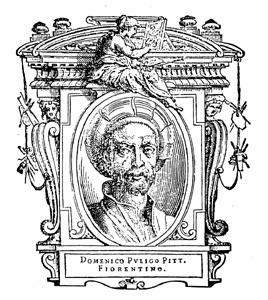
Domenico Puligo (1492–1527) was an Italian painter of the Renaissance, active in Florence. His real name was Domenico di Bartolomeo Ubaldini.
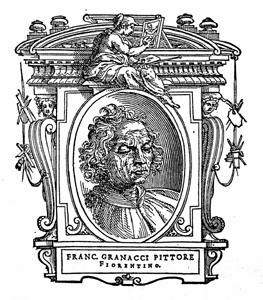
Francesco Granacci was an Italian Renaissance painter active primarily in his native Florence. Though little-known today, he was regarded in his time and is featured in Giorgio Vasari's Lives of the Artists.

The Vision of Saint Jerome of The Madonna and Child with Saints is a painting by the Italian Mannerist artist Parmigianino, executed in 1526–1527. It is in the collection of the National Gallery, in London.
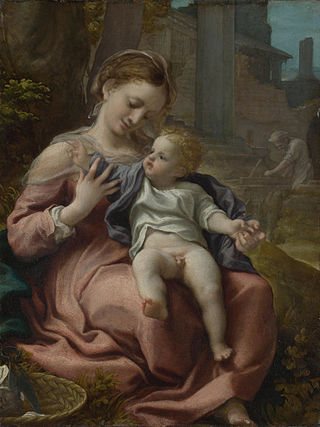
The Madonna of the Basket or the Madonna della Cesta is a painting of c. 1524 by Antonio da Correggio in the National Gallery, London. While it is a Mannerist painting of the Virgin Mary and the Baby Jesus, Correggio included naturalist touches in his composition, like the sewing basket that gives the painting its name.

The Mystic Marriage of St Catherine is a c.1529 oil on panel painting of the mystical marriage of Saint Catherine by Parmigianino, now in the National Gallery, London, who acquired it in 1974. It was engraved by Giulio Bonasone.

Holy Family with the Infant Saint John the Baptist is a painting by Parmigianino, executed c. 1528. It was in the Palazzo Farnese in Rome until 1662, when it moved to Parma. There it hung in the Palazzo del Giardino and later in the Galleria Ducale - the 'Descrizione' of the latter in 1725 called it one of the finest works on display there. It and the rest of the Farnese collection were later moved to Naples and the work was exhibited for a few years in the Palazzo Reale before moving to its present home in the National Museum of Capodimonte. Two early copies remain in the Galleria Nazionale and Palazzo Comunale in Parma.

Lucretia is an oil on panel painting of Lucretia by Parmigianino, from 1540. It was originally in the Farnese collection, and now is held in the Museo nazionale di Capodimonte, in Naples.

Nativity with Angels is a c.1525 oil on panel painting by Parmigianino, now in the Galleria Doria-Pamphili, in Rome. Its shape and dimensions show it to form a diptych with the Doria Madonna in the same gallery.
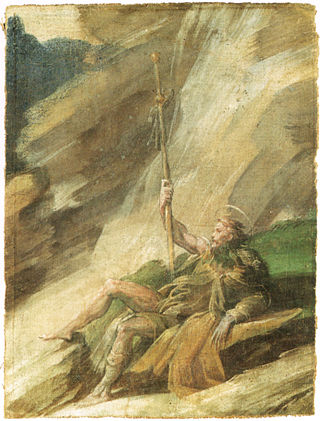
Saint Roch is a tempera on canvas painting by Parmigianino, executed c. 1528, now in a private collection in Parma. It measures 27.8 by 21.5 cm. A preparatory study for the work survives in the Bonnat Museum in Bayonne. Like the artist's Saint Roch with a Donor (1527), its elongated figures are typical of works produced during his stay in Bologna after escaping the Sack of Rome.

Saint Paul Enthroned is an oil-on-canvas painting by the Italian Renaissance painter Domenico Beccafumi, now in the Museo dell'Opera del Duomo in Siena. On the basis of its style it is dated to c. 1515, before his St Catherine of Siena Receiving the Stigmata and after his trip to Rome, where he had come into contact with Sodoma and Florentine artists of the period. The figure of Saint Paul draws on the prophets in Michelangelo's Sistine Chapel ceiling whilst those in the background draw on Dürer and Piero di Cosimo.

Madonna of the Rose is a 1530 oil on panel painting by Parmigianino, now in the Gemäldegalerie in Dresden.

The Kedleston Madonna is an oil on canvas painting by Parmigianino, from c. 1529. It is held in the Kimbell Art Museum, in Fort Worth, Texas, which acquired it from the Kedleston collection in the United Kingdom in 1995.

The Santa Margherita Madonna is an oil on panel painting by Parmigianino, from 1529-1530. It is held in the Pinacoteca Nazionale di Bologna.
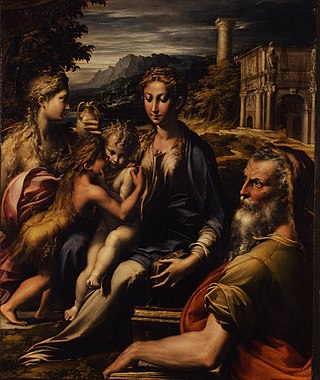
Madonna and Child with Saint Zechariah is an oil on panel painting by Parmigianino, from c. 1530-1533. It is held in the Uffizi, in Florence. It shows the Madonna and Child with Zechariah, father of John the Baptist.